Manufacturer: Sapphire
UK price (as reviewed): MSRP £449 (inc. VAT)
US price (as reviewed): MSRP TBC
Sapphire’s RX 5700 XT Pulse turned out to be a very well-rounded card. High pricing in the UK relative to its US MSRP made it less of a good deal on this side of the pond, but it still picked up a well-earned Recommended badge on these pages. However, we’re now at the stage where more premium models that take longer to develop are landing on shelves, including this one from Sapphire itself, the much anticipated RX 5700 XT Nitro+. And that anticipation was not in vain, dear reader, as this card is awesome.
As a quick aside, we were originally expecting an RX 5700 version of this card too, but from speaking to Sapphire it seems it is focusing its Nitro+ efforts solely on the current flagship Navi GPU, which is fine by us.
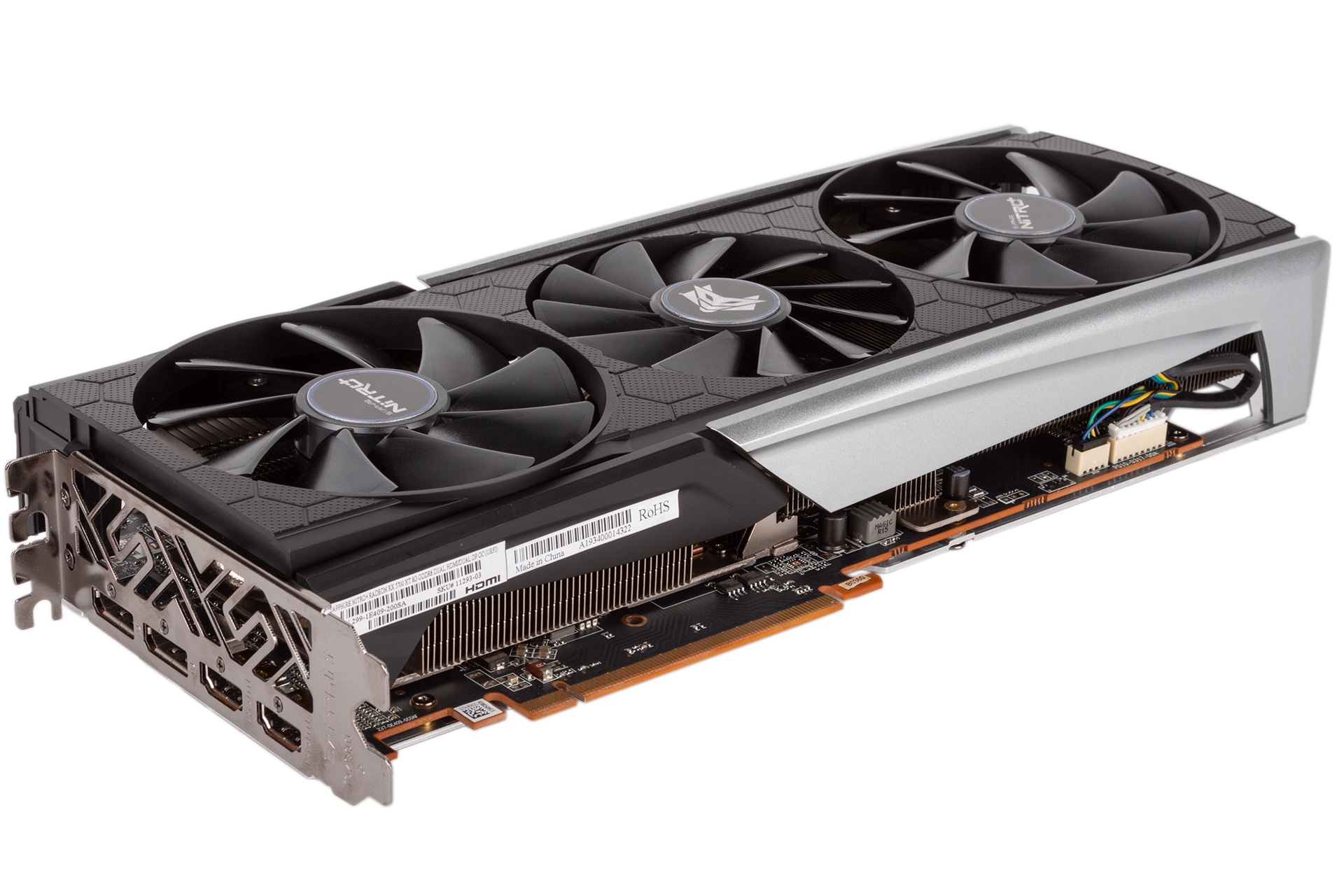
Compared to the Pulse, then, the Nitro+ edition comes with a more aggressive overclock, beefier power delivery to support this, a larger cooler to cope with the added power/heat, and addressable RGB lighting with the option to upgrade the fans with this feature as well. Interestingly, despite these upgrades, Sapphire is targetting a UK price that is merely £10 higher than the Pulse retails for, with £450 expected to position the card smack bang against the PowerColor Red Devil (which we’ll be reviewing next). Whether we’ll see UK retailers drop Pulse pricing to better reflect the $410 US MSRP remains to be seen, or perhaps £450 will remain an on-paper price only; we sincerely hope not.
| Name | AMD Radeon RX 5700 XT | Sapphire RX 5700 XT Pulse | MSI RX 5700 XT Evoke OC | Sapphire RX 5700 XT Nitro+ |
|---|---|---|---|---|
| Base Clock | 1,605MHz | 1,670MHz (+4%) | 1,690MHz (+5%) | 1,770MHz (+10%) |
| Game Clock | 1,755MHz | 1,815MHz (+3.5%) | 1,835MHz (+4.5%) | 1,905MHz (+8.5%) |
| Boost Clock | 1,905MHz | 1,920MHz (+1%) | 1,945MHz (+2%) | 2,010MHz (+5.5%) |
| Memory Data Rate | 14Gbps | 14Gbps (+0%) | 14Gbps (+0%) | 14Gbps (+0%) |
| Total Board Power | 225W | ~241W | ~240W | ~265W |
| Power Connectors | 1x 8-pin, 1x 6-pin | 1x 8-pin, 1x 6-pin | 1x 8-pin, 1x 6-pin | 2 x 8-pin |
| Multi-BIOS | No | Yes, 2 | No (only via download) | Yes, 3 |
| Display Connectors | 3x DP, 1x HDMI | 3x DP, 1x HDMI | 3x DP, 1x HDMI | 2x DP, 2x HDMI |
| Length | 270mm | 258mm | 236mm | 306mm |
| Height | 110mm | 135mm | 128mm | 135mm |
| Slots | 2 | 3 | 3 | 3 |
| Power Phases | 7(+1)+2 | 7(+1)+2 | 7(+1)+2 | 8(+1)+2 |
| LEDs | Yes, red | Yes, red | No | Yes, ARGB |
| Zero RPM Mode | No | Yes | Yes | Yes |
| Warranty (UK) | 2 years min. | 2 years | 3 years | 3 years |
The spec table makes obvious the more aggressive voltage/frequency curve, and all three stated GPU clock metrics are identical to the PowerColor Red Devil – it seems Sapphire has chosen a very specific target for this launch. Even though the memory sadly remains at the stock speed of 14Gbps, the core overclock is plenty enough to drive the total board power consumption up to around 265W, a hefty 40W higher than reference. Sadly, this is simply the cost of higher clock speeds on Navi, as it’s not an especially efficient overclocker.
| BIOS Position |
Performance BIOS | Silent BIOS |
|---|---|---|
| Base Clock | 1,770MHz | 1,670MHz |
| Game Clock | 1,905MHz | 1,815MHz |
| Boost Clock | 2,010MHz | 1,925MHz |
| Memory Data Rate | 14Gbps | 14Gbps |
| GPU Power | ~220W | 195W |
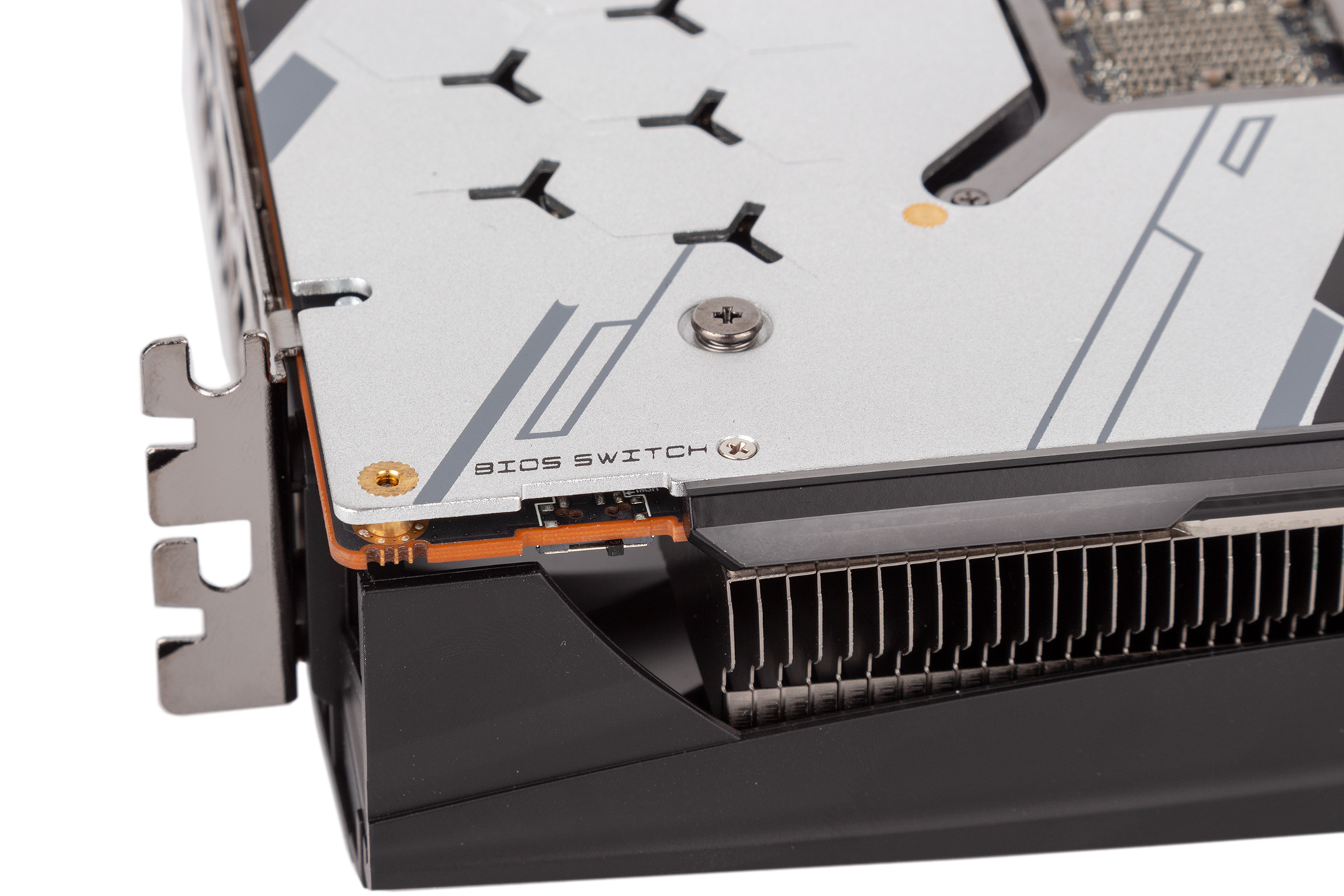
You’re not, however, locked in to this level of performance, as the Sapphire RX 5700 XT Nitro has a multi-BIOS switch with three positions. The primary Performance one is how the card ships and is as outlined above, but the middle position activates the Silent BIOS, which drops the GPU power target (different to total board power) from around 220W to 195W, and brings clock speeds down to the levels shown in the table, which are largely the same as those reported by the RX 5700 XT Pulse’s Performance BIOS, with the idea being that it is still faster than reference but quieter than the primary BIOS. The third position, meanwhile, allows the newly updated Trixx software to take over BIOS switching duties as opposed to the physical switch – perhaps useful if you intend on switching between them with regularity. While it’s great to see a properly implemented multi-BIOS switch, the lack of labelling on the backplate is a minor niggle.
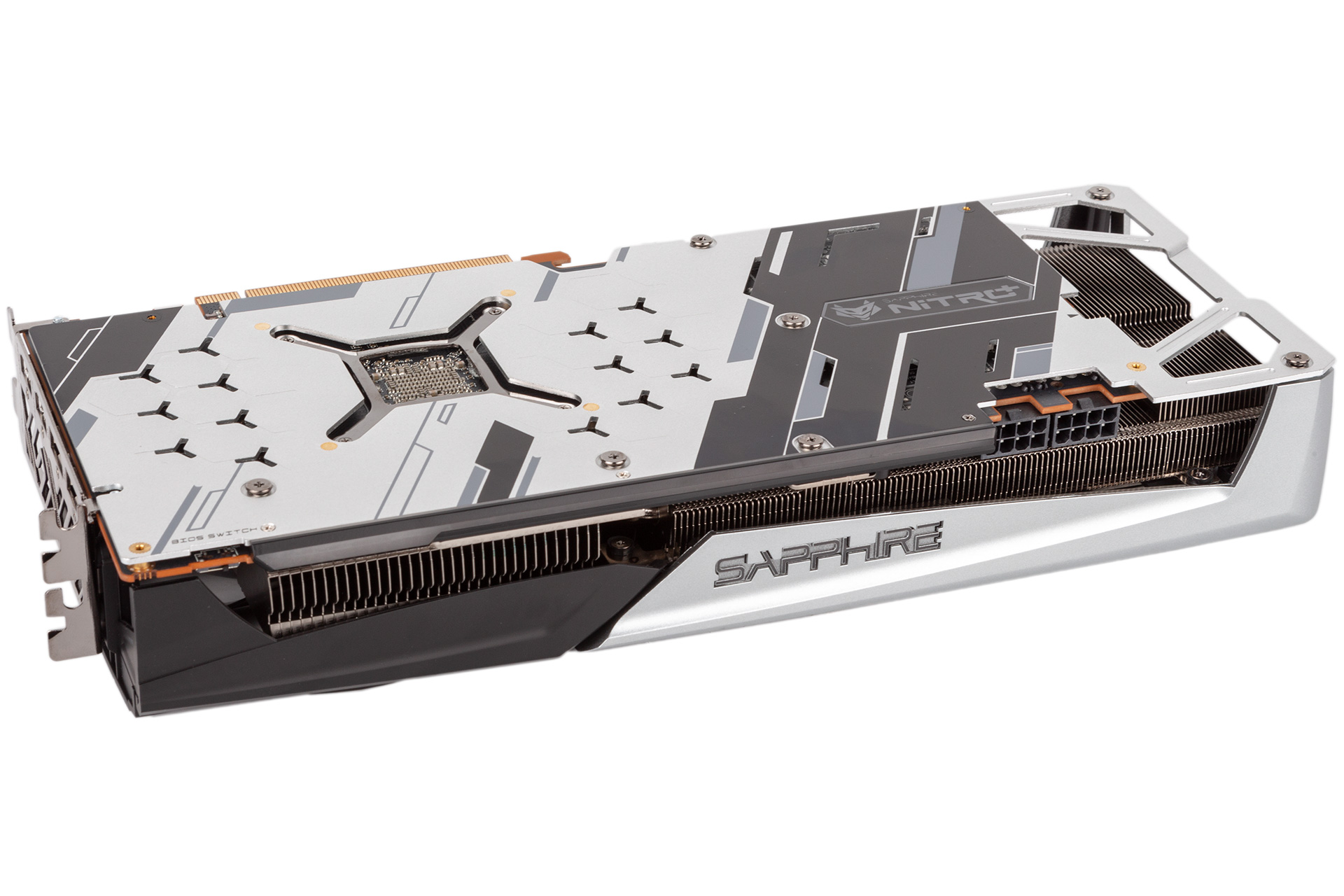
Build quality is solid, although note that the shroud is made of plastic and not aluminium like we saw on MSI’s Evoke OC version. Still, the large backplate is made of aluminium and keeps things rigid, which is important given the large dimensions that could easily make this a challenging installation for certain small form factor cases. The card also tips our scales at 1.15kg.
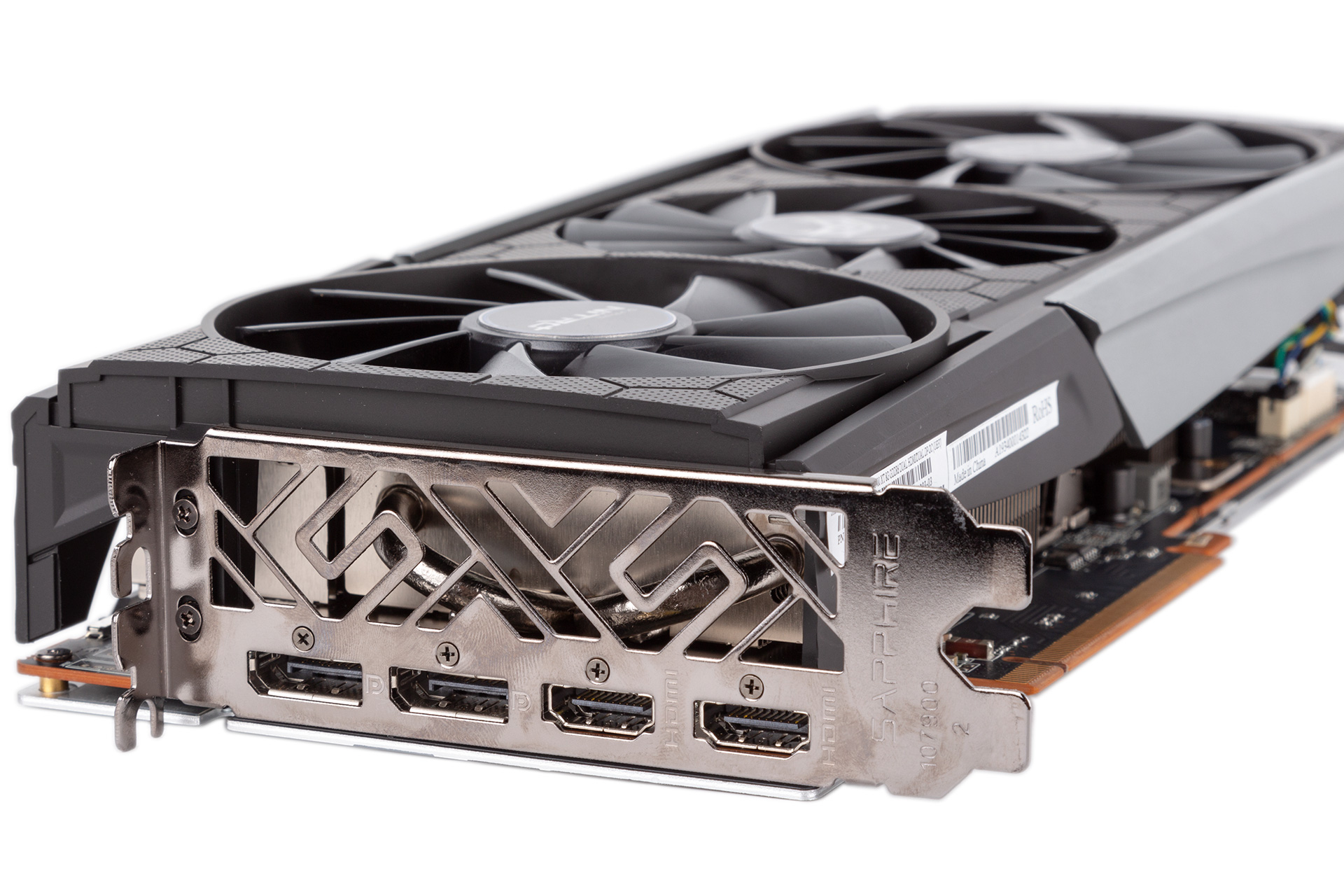
Sapphire has swapped the third DisplayPort of the reference design to a second HDMI, giving users two of each. Described as ‘VR friendly’, it allows you to have an HDMI-based VR headset and an HDMI-based display connected at the same time – possibly helpful for a small set of users and not really anything of note for anyone else.
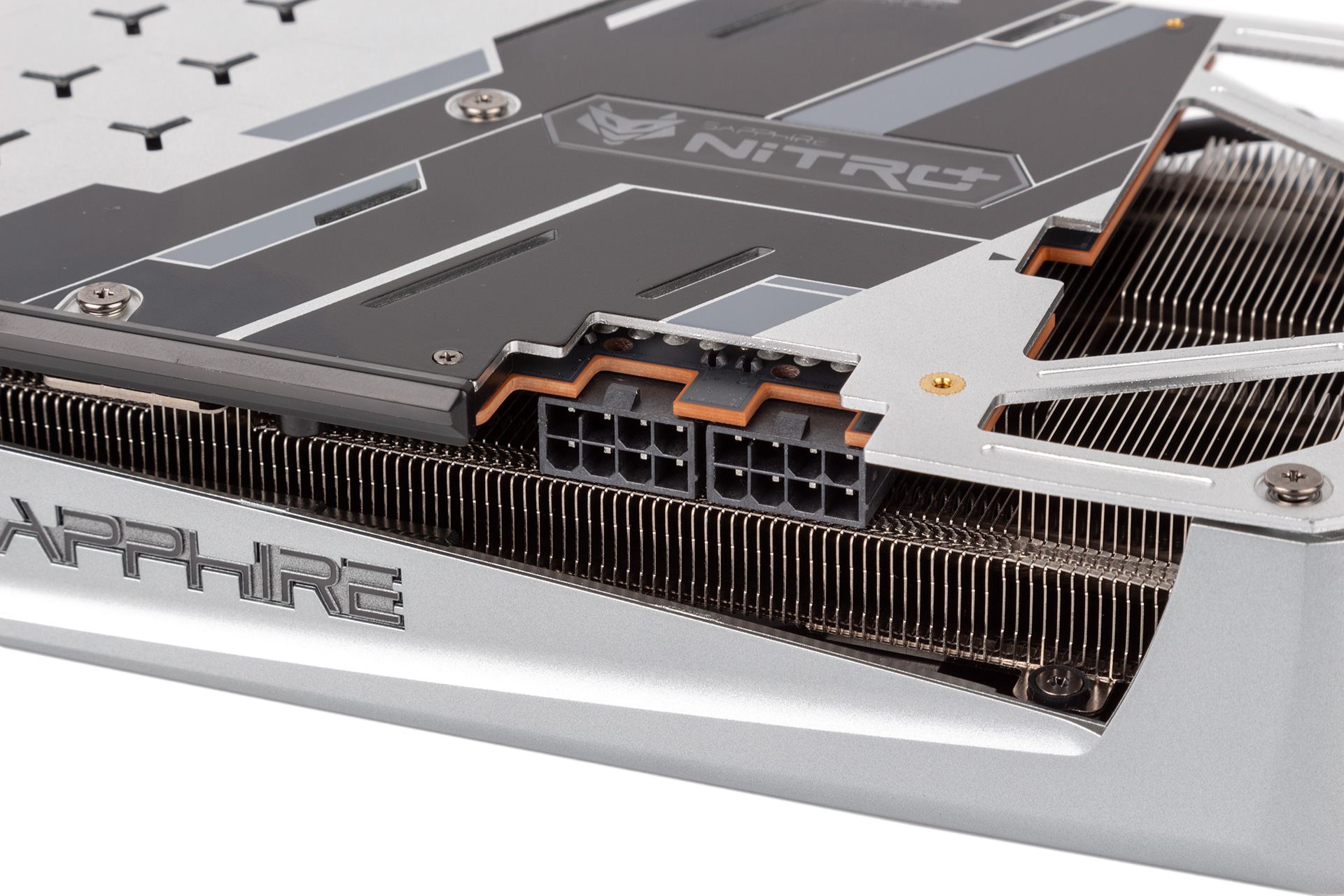
The RX 5700 XT Nitro+ also has bulked up power delivery and accepts dual eight-pin PCIe plugs, giving the card a theoretical maximum power of 375W – plenty to cope with the 265W rating plus any conceivable overclock. The ports are indented relative to the top edge, which gives your plugs room to sit within the frame of the card rather than adding even more to the height.
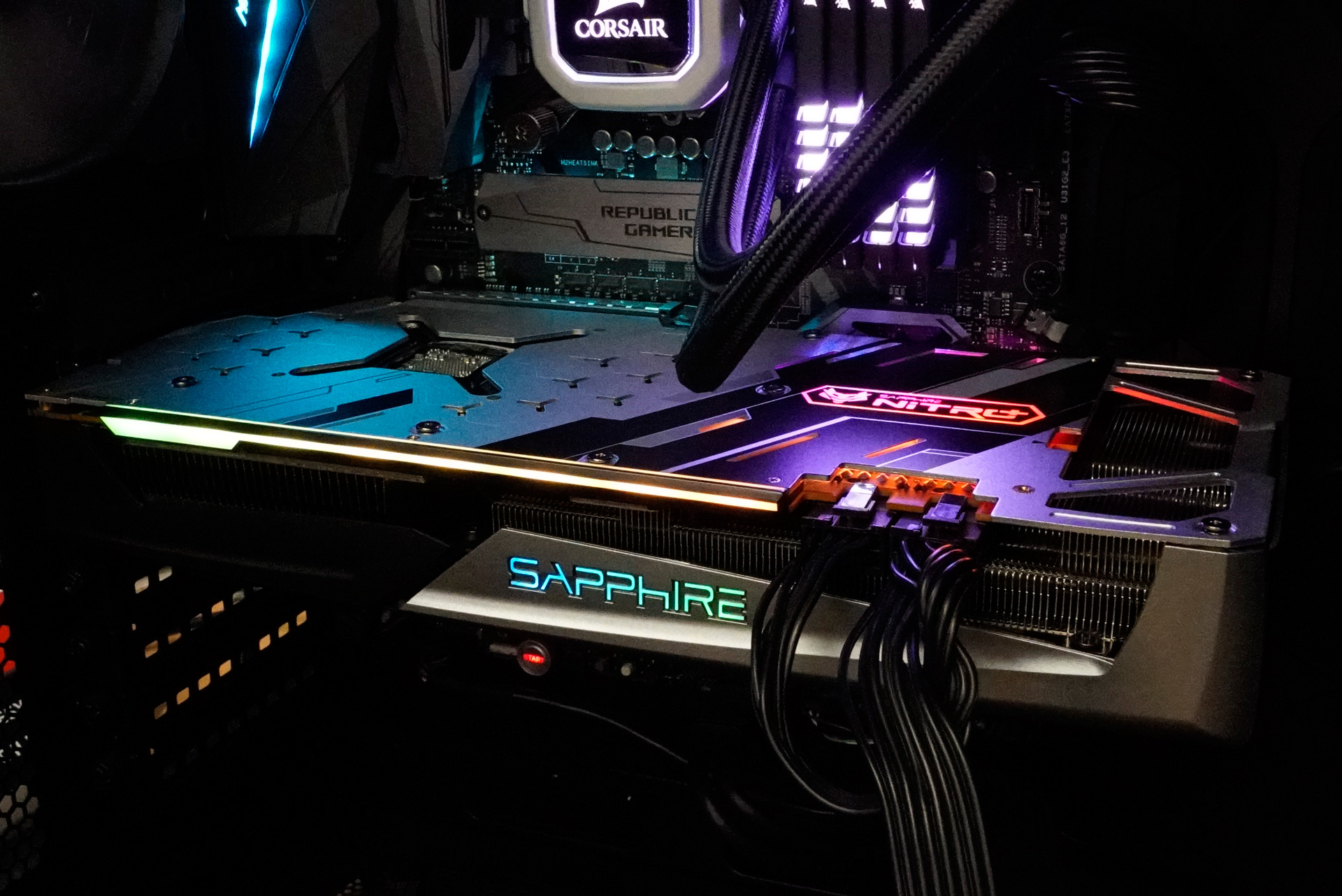
The card is a largely black affair with tiny blue highlights on the fans and some silver sections too. Being predominantly colour-neutral is a good thing, as it also has a splattering of addressable RGB lighting that’s rather fetching. The top-face Sapphire logo, a strip along the edge of the backplate, and another logo on the backplate itself all get the ARGB treatment, and this is easily controlled through the intuitive interface of the Trixx software. Alternatively, a pinout is provided on the PCB so users can hook up the card to 5V addressable headers on their motherboard, although no cables or adaptors are supplied with the card itself.
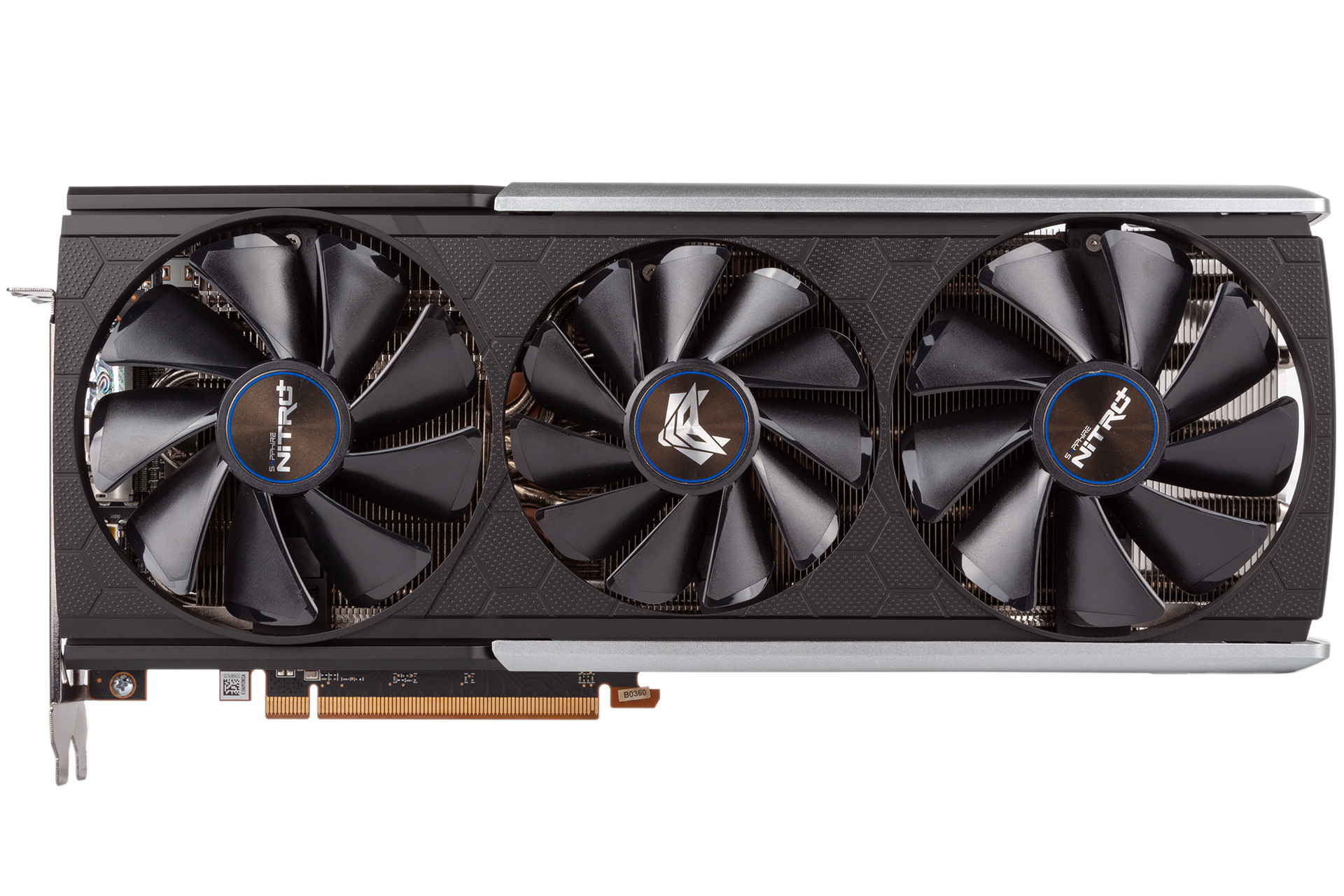
The triple-fan Tri-X cooler is responsible for the size. It comprises two 95mm outer fans and a slightly smaller (87mm) central fan that spins in the opposite direction.
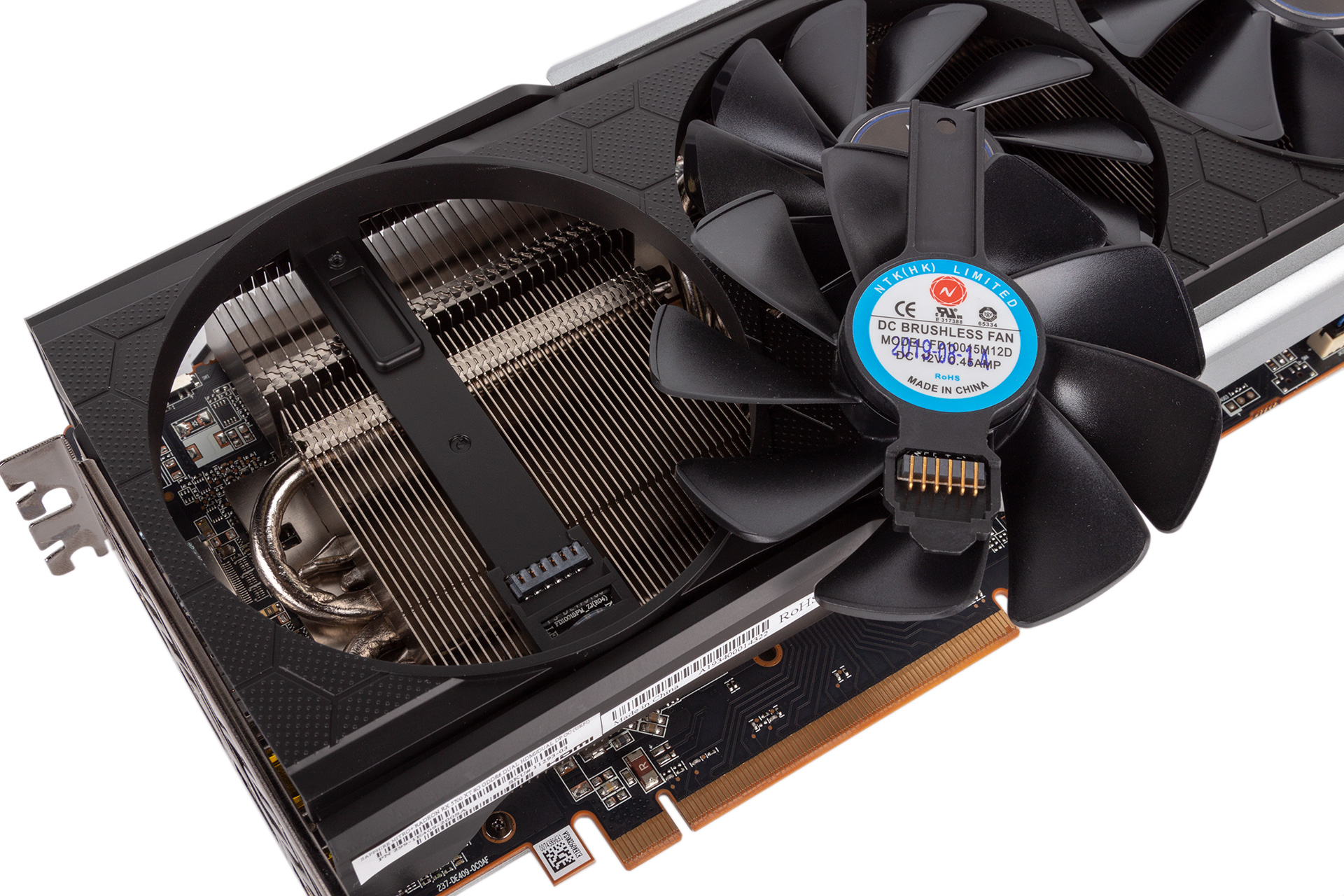
Sapphire again deploys its nifty quick disconnect system, which means you only need to remove one screw (accessed directly through the fins) to remove a fan for cleaning or replacement. As moving parts, fans are quite prone to failure, so this is potentially very handy. These fans feature a zero RPM mode too, kicking in at a GPU temperature of 60°C and switching off whenever you’re at the 50°C mark, and they are all synchronised to the same control signal.
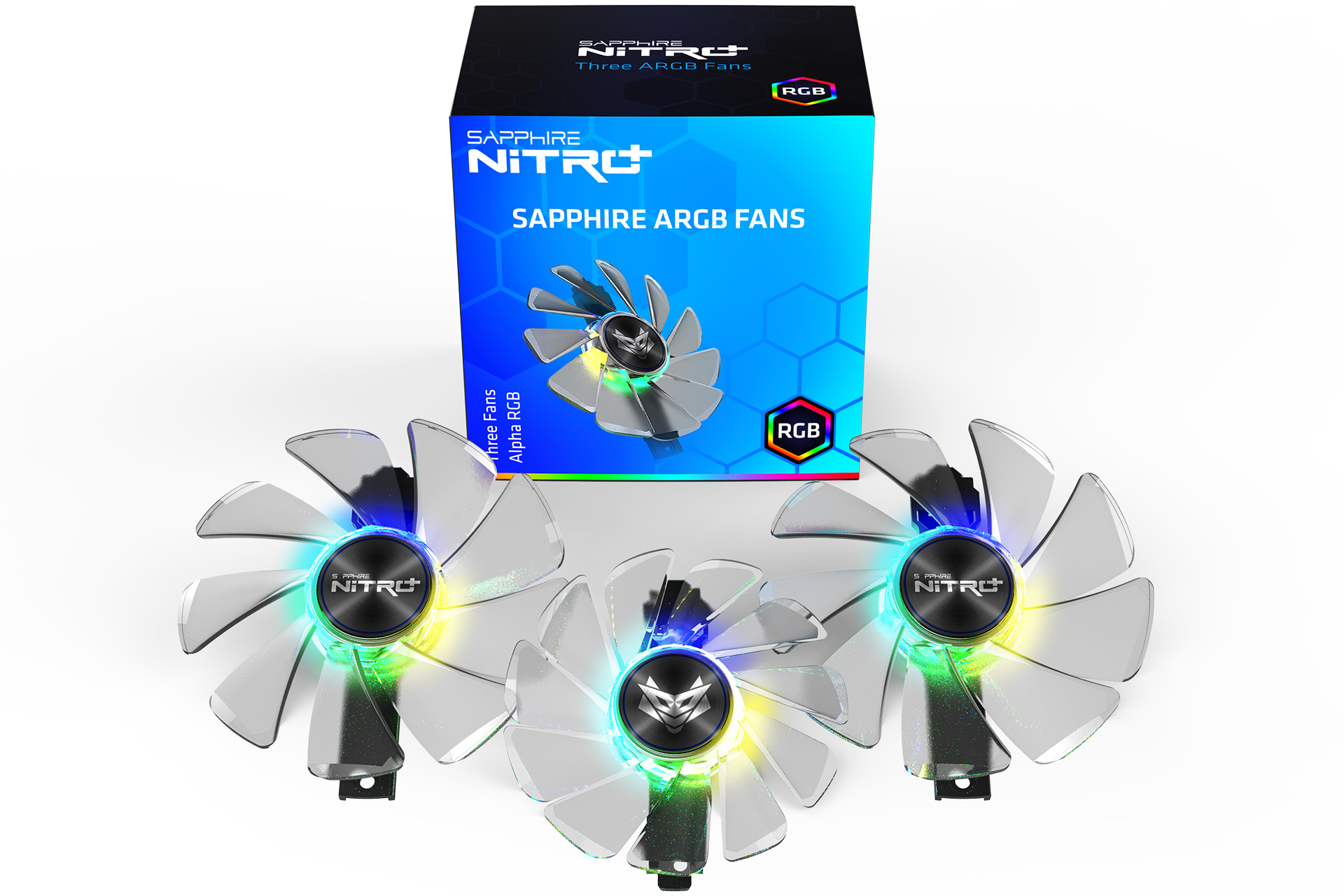
The quick disconnect feature will possibly see more use on this card than elsewhere, as Sapphire will be making available an ARGB fan upgrade kit for it. Set to come in at £30, it includes replacement models for all three fans with translucent blades and a central RGB LED ring. We like this idea, as it prevents users with less interest in lighting paying over the odds but gives those who are more interested an easy and potentially striking upgrade, especially for vertically mounted cards (though the ‘2.3-slot’ is something to be wary of there). Sapphire’s Trixx software has a Fan Check section, which checks the maximum fan speed one by one to check any fans installed meet a minimum criteria. The ARGB fans are designed to offer identical performance in terms of airflow/noise, though we weren’t sent any to test.

Disassembling the rest of the cooler takes more effort but isn’t too tricky. With the PCB exposed, we see Sapphire has bumped the GPU power phases from seven to eight, but there’s no change for the ASIC, memory, or memory bus phases. That said, Sapphire does use its fourth-generation Black Diamond chokes on this card (for the GPU phases), which come with a bunch of claims relating to operating temperature and efficiency advantages over “regular” chokes.
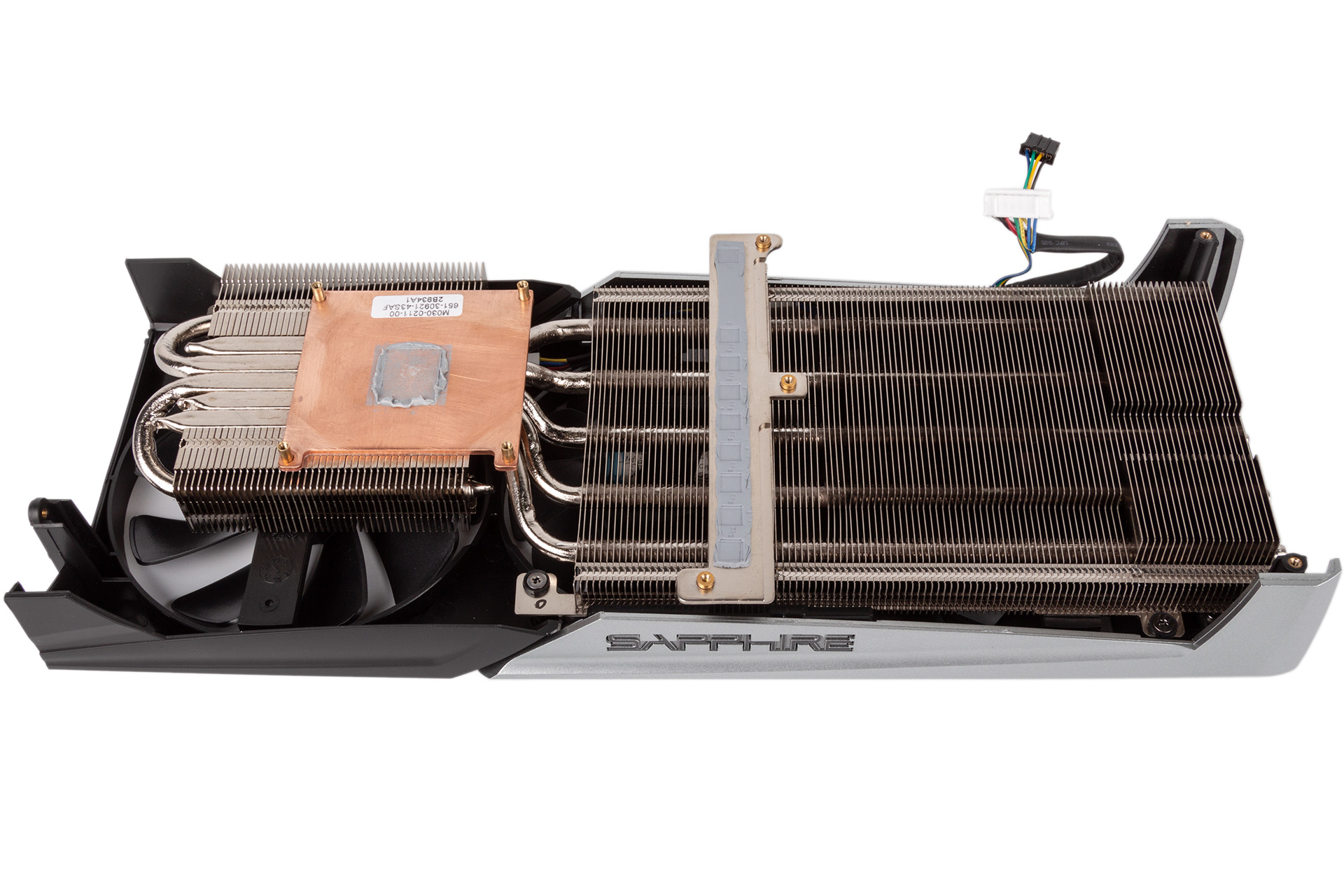
The cooling solution is the most advanced we’ve seen thus far for the RX 5700 XT, and Sapphire’s design is hard to fault. A large copper baseplate draws heat away from the GPU via thermal paste, with five heat pipes then dispersing this through a small aluminium fin stack above and a much larger one that fills out the card’s volume nicely. This secondary heatsink is also connected directly to the 8+1 GPU MOSFETs via thermal pads and a soldered contact plate. These VRMs are further assisted by thermal pads on the back, which use the backplate as another heatsink.

There’s also a totally separate and impressively large heatsink used to cool the eight GDDR6 memory packages as well as the MOSFETs for the two memory VRMs, the MOSFET for the the memory bus VRM, and the VRM IC. The memory modules are fully covered by the pads, and there are proper fins as part of this arrangement that will benefit directly from the airflow.
One area where we’d like to have seen Sapphire push things further is the warranty, as two years is only the minimum. MSI is able to offer three years with its Evoke OC, so it would have been good to see this matched. Update 16/09/2019: Sapphire has been in touch to confirm that it will indeed be offering a three-year warranty with this card, which is a match for MSI and a nice improvement.

MSI MPG Velox 100R Chassis Review
October 14 2021 | 15:04

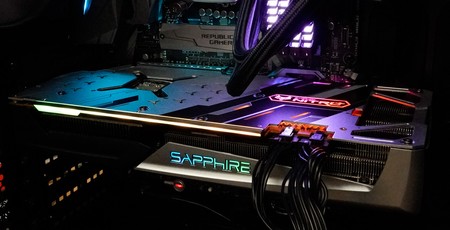
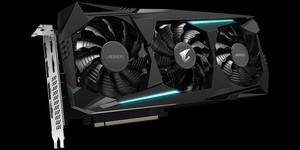
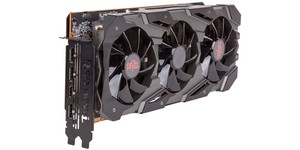
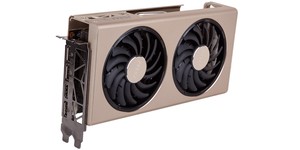




Want to comment? Please log in.